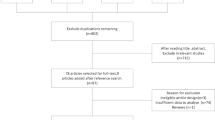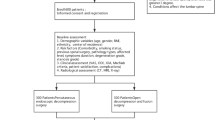Abstract
Purpose
Selection of anatomic region of spine for decompression in patients with symptomatic tandem spinal stenosis (TSS) remains a challenge due to the confusing clinical presentation as well as uncertain evidence. A systematic review and meta-analysis of observational studies were conducted to compare the outcomes between simultaneous decompression of all stenotic regions (cervical and lumbar, Group 1) and decompression of only the most symptomatic stenotic region (cervical/lumbar, Group 2) in patients with TSS.
Methods
A systematic review was conducted, and a comprehensive literature search with well-established inclusion and exclusion criteria with JOA score as an outcome measure was done on PubMed, Google Scholar, and EMBASE database (till January 2021). Observational studies reporting outcomes after simultaneous decompression or only the most symptomatic region were included. NIH quality assessment tool was used to check the quality of each study, and treatment effects were calculated using Dersimonian and Laird random effects model.
Results
Ten studies were included in the analysis out of which all were retrospective observational studies (Level 4 evidence) except one (Level 3 evidence). Overall proportional meta-analysis showed no significant difference in change in JOA scores, operative time, blood loss, total and major complications between Group 1 and Group 2. However, minor complications were significantly increased on performing decompression of both regions simultaneously (p = 0.04). On performing subgroup analysis comparing cervical surgery cohort with lumbar surgery cohort, no difference was found in change in JOA score and requirement of second-stage surgery.
Conclusion
Decompression of the most symptomatic region alone irrespective of its location has equal clinical outcomes with less complication rate than simultaneous decompression in patients with TSS.






Similar content being viewed by others
References
Teng P, Papatheodorou C (1964) Combined cervical and lumbar spondylosis. Arch Neurol 10:298–307
Dagi TF, Tarkington MA, Leech JJ (1987) Tandem lumbar and cervical spinal stenosis: natural history, prognostic indices, and results after surgical decompression. J Neurosurg 66:842–849
Hu P, Yu M, Liu X et al (2017) Surgeries for patients with tandem spinal stenosis in cervical and thoracic spine: combined or staged surgeries? World neurosurgery 107:115–123
Schaffer JC, Raudenbush BL, Molinari C, Molinari RW (2015) Symptomatic triple-region spinal stenosis treated with simultaneous surgery: case report and review of the literature. Global Spine J 5:513–521. https://doi.org/10.1055/s-0035-1566226
Fushimi K, Miyamoto K, Hioki A et al (2013) Neurological deterioration due to missed thoracic spinal stenosis after decompressive lumbar surgery: A report of six cases of tandem thoracic and lumbar spinal stenosis. Bone Joint J. https://doi.org/10.1302/0301-620X.95B10.31222
Hu P, Yu M, Liu X et al (2017) One-staged combined decompression for the patients with cervico-thoracic tandem spinal stenosis. Eur Spine J 26:374–381
Hong CC, Liu KPG (2015) A rare case of multiregional spinal stenosis: clinical description, surgical complication, and management concept review. Global Spine J 5:49–54. https://doi.org/10.1055/s-0034-1378139
Inoue T, Ando K, Kobayashi K et al (2021) Primary cervical decompression surgery may improve lumbar symptoms in patients with tandem spinal stenosis. Eur Spine J. https://doi.org/10.1007/s00586-020-06693-0
Aydogan M, Ozturk C, Mirzanli C et al (2007) Treatment approach in tandem (concurrent) cervical and lumbar spinal stenosis. Acta Orthop Belg 73:234
Luo C-A, Kaliya-Perumal A-K, Lu M-L et al (2019) Staged surgery for tandem cervical and lumbar spinal stenosis: which should be treated first? Eur Spine J 28:61–68
Kikuike K, Miyamoto K, Hosoe H, Shimizu K (2009) One-staged combined cervical and lumbar decompression for patients with tandem spinal stenosis on cervical and lumbar spine: analyses of clinical outcomes with minimum 3 years follow-up. Clinical Spine Surgery 22:593–601
Eskander MS, Aubin ME, Drew JM et al (2011) Is there a difference between simultaneous or staged decompressions for combined cervical and lumbar stenosis? Clinical Spine Surgery 24:409–413
Krishnan A, Dave BR, Kambar AK, Ram H (2014) Coexisting lumbar and cervical stenosis (tandem spinal stenosis): an infrequent presentation. retrospective analysis of single-stage surgery (53 cases). Eur Spine J 23:64–73
Singrakhia MD, Malewar NR, Deshmukh S, Deshmukh SS (2019) Prospective analysis of functional outcome of single-stage surgical treatment for symptomatic tandem spinal stenosis. Indian J Orthop 53:315–323
Aiwale AB, Patel PR, Paspala SAB, Murthy TR (2019) Simultaneous cervical and lumbar spine surgery: Retrospective analysis of 45 cases. Indian J Neurosurg 8:047–052
Tsutsumimoto T, Shimogata M, Yui M et al (2012) The natural history of asymptomatic lumbar canal stenosis in patients undergoing surgery for cervical myelopathy. J bone Joint Surg British 94:378–384
Li H, Chen Z, Li X et al (2017) Prioritized cervical or lumbar surgery for coexisting cervical and lumbar stenosis: prognostic analysis of 222 case. Int J Surg 44:344–349
Yamada T, Yoshii T, Yamamoto N et al (2018) Clinical outcomes of cervical spinal surgery for cervical myelopathic patients with coexisting lumbar spinal canal stenosis (tandem spinal stenosis): a retrospective analysis of 297 cases. Spine 43:E234–E241
Yamada T, Yoshii T, Yamamoto N et al (2018) Surgical outcomes for lumbar spinal canal stenosis with coexisting cervical stenosis (tandem spinal stenosis): a retrospective analysis of 565 cases. J Orthop Surg Res 13:1–8
Pennington Z, Alentado VJ, Lubelski D et al (2019) Quality of life changes after lumbar decompression in patients with tandem spinal stenosis. Clin Neurol Neurosurg 184:105455. https://doi.org/10.1016/j.clineuro.2019.105455
Alvin MD, Alentado VJ, Lubelski D et al (2018) Cervical spine surgery for tandem spinal stenosis: the impact on low back pain. Clin Neurol Neurosurg 166:50–53
Hsieh C-H, Huang T-J, Hsu RW (1998) Tandem spinal stenosis: clinical diagnosis and surgical treatment. Changgeng Yi Xue Za Zhi 21:429–435
Moher D, Liberati AA, Tetzlaff J, Altman DG (2009) Preferred reporting items for systematic reviews and meta-analyses: the PRISMA statement. BMJ 339:b2535
Higgins JP (2011) Cochrane handbook for systematic reviews of interventions. Version 5.1. 0 [updated March 2011]. The Cochrane Collaboration. www cochrane-handbook org
Ahmed KM, Al Dhubaib B (2011) Zotero: a bibliographic assistant to researcher. J Pharmacol Pharmacother 2:303
Study Quality Assessment Tools | NHLBI, NIH. https://www.nhlbi.nih.gov/health-topics/study-quality-assessment-tools. Accessed 13 Feb 2021
Vitzthum H-E, Dalitz K (2007) Analysis of five specific scores for cervical spondylogenic myelopathy. Eur Spine J 16:2096–2103. https://doi.org/10.1007/s00586-007-0512-x
Viechtbauer W (2010) Conducting meta-analyses in R with the metafor package. J Stat Softw 36:1–48
Higgins JP, Thompson SG (2002) Quantifying heterogeneity in a meta-analysis. Stat Med 21:1539–1558
Sterne JA, Sutton AJ, Ioannidis JP et al (2011) Recommendations for examining and interpreting funnel plot asymmetry in meta-analyses of randomised controlled trials. Bmj. https://doi.org/10.1136/bmj.d4002
Epstein NE, Epstein JA, Carras R et al (1984) Coexisting cervical and lumbar spinal stenosis: diagnosis and management. Neurosurgery 15:489–496
Olivier Brice N, Sinclair Brice KB, Hugues Brieux EM (2019) Tandem spinal stenosis at the brazzaville academic hospital. Iranian J Neurosurg 5:125–132
Rezvani M, Ghaed AA, Tabesh H (2016) Comparison of 1-stage versus 2-stage decompression, fusion and instrumentation surgery in patients with coexisting cervical and lumbar degenerative spondylotic disorders; a prospective, randomized, controlled clinical trial study
Felbaum DR, Fayed I, Stewart JJ, Sandhu FA (2016) Relief of lumbar symptoms after cervical decompression in patients with tandem spinal stenosis presenting with primarily lumbar pain. Cureus. https://doi.org/10.7759/cureus.940
Molinari RW, Flanigan R, Yaseen Z (2012) Tandem spinal stenosis (TSS): literature review and report of patients treated with simultaneous decompression. Current Orthop Pract 23:356–363
Overley SC, Kim JS, Gogel BA et al (2017) Tandem spinal stenosis: a systematic review. JBJS reviews 5:e2
Swanson BT (2012) Tandem spinal stenosis: a case of stenotic cauda equina syndrome following cervical decompression and fusion for spondylotic cervical myelopathy. J Man Manip Ther 20:50–56. https://doi.org/10.1179/2042618611Y.0000000010
Jannelli G, Baticam NS, Tizi K et al (2019) Symptomatic tandem spinal stenosis: a clinical, diagnostic, and surgical challenge. Neurosurg Rev 43:1–7
Bajwa NS, Toy JO, Young EY, Ahn NU (2012) Is congenital bony stenosis of the cervical spine associated with lumbar spine stenosis? an anatomical study of 1072 human cadaveric specimens. J Neurosurg Spine 17:24–29
Lee MJ, Garcia R, Cassinelli EH et al (2008) Tandem stenosis: a cadaveric study in osseous morphology. Spine J 8:1003–1006. https://doi.org/10.1016/j.spinee.2007.12.005
Adamova B, Bednarik J, Andrasinova T et al (2015) Does lumbar spinal stenosis increase the risk of spondylotic cervical spinal cord compression? Eur Spine J 24:2946–2953. https://doi.org/10.1007/s00586-015-4049-0
Nagata K, Yoshimura N, Hashizume H et al (2017) The prevalence of tandem spinal stenosis and its characteristics in a population-based MRI study: the wakayama spine study. Eur Spine J 26:2529–2535
Lee S-H, Kim K-T, Suk K-S et al (2010) Asymptomatic cervical cord compression in lumbar spinal stenosis patients: a whole spine magnetic resonance imaging study. Spine 35:2057–2063
LaBan MM, Green ML (2004) Concurrent (tandem) cervical and lumbar spinal stenosis: a 10-yr review of 54 hospitalized patients. Am J Phys Med Rehabil 83:187–190. https://doi.org/10.1097/01.phm.0000113405.48879.45
Smorgick Y, Granek T, Mirovsky Y et al (2020) Routine sagittal whole-spine magnetic resonance imaging in finding incidental spine lesions. MAGMA. https://doi.org/10.1007/s10334-020-00882-0
Bhandutia A, Brown L, Nash A et al (2019) Delayed diagnosis of tandem spinal stenosis: a retrospective institutional review. Int J Spine Surg 13:283–288
Baker JF (2020) Evaluation and treatment of tandem spinal stenosis. JAAOS-J Am Acad Orthop Surg 28:229–239
Ghobrial GM, Oppenlander ME, Maulucci CM et al (2014) Management of asymptomatic cervical spinal stenosis in the setting of symptomatic tandem lumbar stenosis: a review. Clin Neurol Neurosurg 124:114–118
Wilkes LL (1980) Paraplegia from operating position and spinal stenosis in non-spinal surgery: a case report. Clin Orthop Relat Res 146:148–149
Deem S, Shapiro HM, Marshall LF (1991) Quadraplegia in a patient with cervical spondylosis after thoracolumbar surgery in the prone position. J Am Soc Anesthesiol 75:527–528
Funding
The authors did not receive support from any organization for the submitted work.
Author information
Authors and Affiliations
Corresponding author
Ethics declarations
Conflicts of Interest
The authors have no conflicts of interest to declare that are relevant to the content of this article.
Data availability
The datasets generated during and/or analyzed during the current study are available from the corresponding author on reasonable request.
Additional information
Publisher's Note
Springer Nature remains neutral with regard to jurisdictional claims in published maps and institutional affiliations.
Authors declare that any portion of the contents of the paper have not been presented previously
Rights and permissions
About this article
Cite this article
Mittal, S., Ahuja, K., Sudhakar, P.V. et al. Simultaneous decompression of all stenotic regions versus decompression of only the most symptomatic region in patients with tandem spinal stenosis: a systematic review and meta-analysis. Eur Spine J 31, 561–574 (2022). https://doi.org/10.1007/s00586-021-07078-7
Received:
Revised:
Accepted:
Published:
Issue Date:
DOI: https://doi.org/10.1007/s00586-021-07078-7




